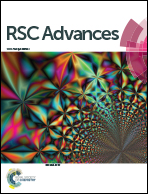Novel thermo-responsive hydrogel microspheres with calixcrown host molecules as cross-links for highly specific binding and controllable release of cesium†
Abstract
In this study, a new bifunctional calixcrown host molecule with superb complexation of cesium (Cs) (distribution ratio D > 45) was synthesized, which was first employed as cross-linker for building a novel class of thermo-responsive poly(N-isopropylacrylamide) microspheres. AFM cross-section analysis revealed a negative shift of lower critical solution temperature (LCST) of the hydrogel microspheres, owing to the calixcrown moieties at the cross-links affecting the balance of hydrogen bonding and hydrophobic association in the 3D polymer network. Due to the host–guest ion recognition, the hydrogel microspheres showed the highest selectivity factors (SFs) so far of Cs over the competing alkali cations (SFCs/K = 20.0, SFCs/Na = 34.0). Moreover, since the thermo-triggered conformation change of polymer network interacting with the calixcrown–Cs complexation, the hydrogel microspheres exhibited a temperature-sensitive ion-binding behavior, which provided a feasible mechanism for controllable release of the bound Cs by tuning the surrounding temperature. Reversible Cs uptake-release cycles were achieved without compromising their complexation property. From a practical perspective, the calixcrown integrated hydrogel microspheres were proven to be able to effectively remove the trace Cs in real seawater (removal rate ∼ 93.5%).


 Please wait while we load your content...
Please wait while we load your content...